大学英语语法 并列与从属
- 格式:ppt
- 大小:621.50 KB
- 文档页数:33

第十一章并列与从属并列在大多数情况下,并列结构由并列连词连接而成。
不同的并列连词有不同的含义,因此被连接的成分就具有不同的关系。
我们需要注意的是,在一个特定的句法环境中,一个并列连接词与另一并列连接词所起作用的方式是不同的。
所以我们需要辨别并列连接词及其用法。
并列连接词最常见的并列连接词是and,or和but,它们被称为“中心并列连接词”或“纯粹并列连接词”,因为他们主要用来连接在同一句法层上的语言单位。
其他并列连接词具有中心并列连接词的一部分句法和语义特征。
“关联并列连接词”几乎总是连接两个并列成分。
此外,还有几个连接词被称为“半并列连接词”,因为它们有时用作并列连接词。
还有一类称为“边际并列连接词”,因为它们有时用作并列连接词,有时用作从属连接词或介词。
常用的并列连接词如下:中心并列连接词:and,or,but关联并列连接词:both… and, either.., or, not...but, neither...nor, not only.., but also半并列连接词:nor, so, yet边际并列连接词:as well as,as much as,rather than,more than尽管上述列举不够详尽,但这些并列连接词在连接句子成份方面起了重要作用d and,or和but是中心并列连接词,不仅因为它们用法如此,还因为它们代表了并列成分之间的三种基本关系:列举、选择和对比。
其他并列连接词相对于这三个并列连接词就边缘些。
但是,正如我们很快就会看到的那样,一个并列连接词在不同的词境中代表不同的关系,即使中心并列连接词在语义上也不那么纯粹。
and和有关并列连接词并列连接词and常用来连接一组并列成分:结构是A and B。
其他能起类似作用的并列连接词有:both…and,not only…but also,as well as, not.., or,not.., nor,neither.., nor.例如:①I gave her a cup of tea and some biscuits.我给她一杯茶和一些饼干。
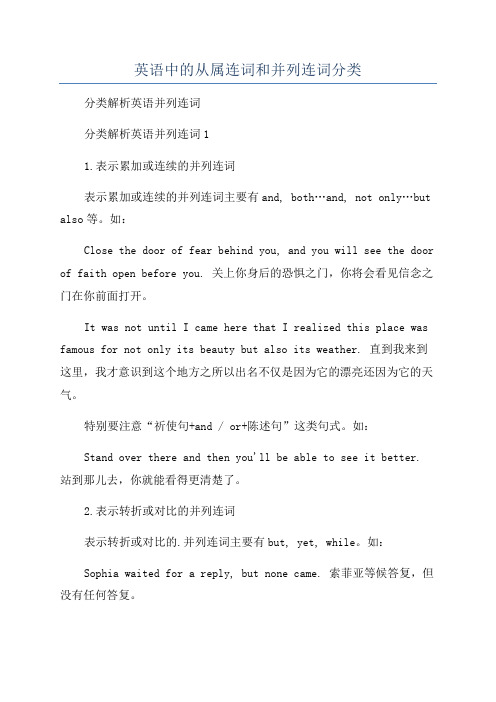
英语中的从属连词和并列连词分类分类解析英语并列连词分类解析英语并列连词11.表示累加或连续的并列连词表示累加或连续的并列连词主要有and, both…and, not only…but also等。
如:Close the door of fear behind you, and you will see the door of faith open before you. 关上你身后的恐惧之门,你将会看见信念之门在你前面打开。
It was not until I came here that I realized this place was famous for not only its beauty but also its weather. 直到我来到这里,我才意识到这个地方之所以出名不仅是因为它的漂亮还因为它的天气。
特别要注意“祈使句+and / or+陈述句”这类句式。
如:Stand over there and then you'll be able to see it better. 站到那儿去,你就能看得更清楚了。
2.表示转折或对比的并列连词表示转折或对比的.并列连词主要有but, yet, while。
如:Sophia waited for a reply, but none came. 索菲亚等候答复,但没有任何答复。
I woke up with a bad headache, yet by the evening the pain had gone. 我醒来时,头疼得厉害,但到了晚上,疼痛就消失了。
特别要注意while一词。
如:The first two services are free, while the third costs 35.00. 前两项服务免费,但是第三项服务要花35英镑。
In some places women are expected to earn money while men work at home and raise their children. 在一些地方,妇女要去赚钱,而男人操持家务并照顾孩子。

并列连词和从属连词的用法归纳在语言表达中,连词起着连接不同部分和句子的重要作用。
其中,并列连词和从属连词是两类常见的连词。
本文将对并列连词和从属连词的用法进行归纳和总结,并给出一些例子,以帮助读者更好地理解和应用。
一、并列连词并列连词用于连接同等重要的词、短语或句子,使它们具有平等的地位。
下面是一些常见的并列连词及其用法:1. and:表示并列关系,连接两个相同或相似的事物或概念。
例如:- I like apples and oranges.- He is tall and handsome.2. but:表示转折关系,连接两个相对或相对立的事物或概念。
例如:- She is rich, but she is not happy.- The weather is cold, but I still want to go out.3. or:表示选择关系,连接两个或多个选项中的一个。
例如:- Would you like tea or coffee?- You can travel by train or by bus.4. nor:用于否定并列句子中,表示前面所述的情况在此处也不适用。
例如:- He neither drinks nor smokes.- She did not work, nor did she study.5. for:表示因果关系或解释原因,连接因果关系或解释性的句子。
例如:- He studied hard, for he wanted to pass the exam.- She is tired, for she worked all day.二、从属连词从属连词用于连接两个句子或从句,表示主从关系,其中一个从句在逻辑上依赖于另一个。
下面是一些常见的从属连词及其用法:1. that:用于引导一个宾语从句,作为动词或形容词的宾语。
例如:- I know that he is coming.- She said that she was tired.2. if:表示条件关系,引导一个条件从句。

(知识点)并列连词与从属连词的区别与用法知识点:并列连词与从属连词的区别与用法在语法中,连词是连接词组、短语或句子的词语。
并列连词和从属连词是两种常用的连词类型,它们在使用上有一些区别和特点。
一、并列连词的用法1. 并列连词是用来连接同等地位的词组、短语或句子,表示并列关系。
例如:- He likes to play basketball and soccer.(他喜欢打篮球和足球。
) - I want to eat an apple or an orange.(我想吃一个苹果或一个橙子。
)2. 常见的并列连词有:and(和)、but(但是)、or(或者)、for (因为)、so(所以)等。
例如:- I like to swim and dance.(我喜欢游泳和跳舞。
)- She is smart but lazy.(她聪明但是懒惰。
)- You can choose tea or coffee.(你可以选择茶或咖啡。
)- He is tired, so he wants to rest.(他累了,所以他想休息。
)3. 并列连词连接的内容在语法结构上应保持一致,即词性相同、句子结构相同等。
例如:- I like to swim and dance.(我喜欢游泳和跳舞。
)二、从属连词的用法1. 从属连词用来连接主从复合句中的从属分句和主句,表示从属关系,从属连词引导的从属分句不能单独成句。
例如:- I will study hard if I want to pass the exam.(如果我想通过考试,我会努力学习。
)2. 常见的从属连词有:if(如果)、when(当)、because(因为)、although(尽管)等。
例如:- If it rains, we will stay at home.(如果下雨的话,我们会待在家里。
)- When I see her, I will say hello.(当我见到她时,我会问候。
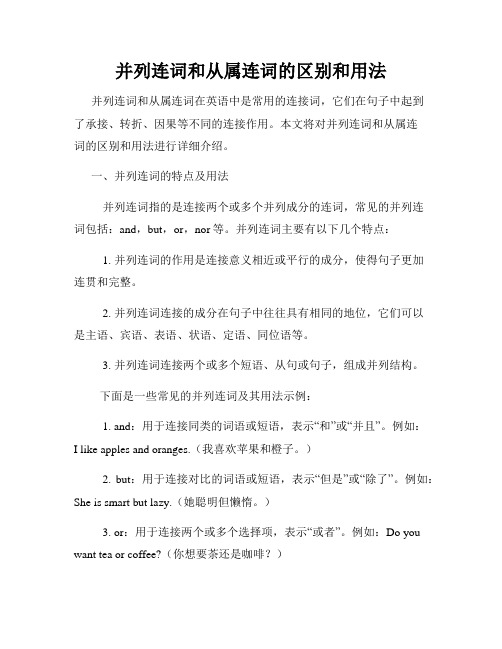
并列连词和从属连词的区别和用法并列连词和从属连词在英语中是常用的连接词,它们在句子中起到了承接、转折、因果等不同的连接作用。
本文将对并列连词和从属连词的区别和用法进行详细介绍。
一、并列连词的特点及用法并列连词指的是连接两个或多个并列成分的连词,常见的并列连词包括:and,but,or,nor等。
并列连词主要有以下几个特点:1. 并列连词的作用是连接意义相近或平行的成分,使得句子更加连贯和完整。
2. 并列连词连接的成分在句子中往往具有相同的地位,它们可以是主语、宾语、表语、状语、定语、同位语等。
3. 并列连词连接两个或多个短语、从句或句子,组成并列结构。
下面是一些常见的并列连词及其用法示例:1. and:用于连接同类的词语或短语,表示“和”或“并且”。
例如:I like apples and oranges.(我喜欢苹果和橙子。
)2. but:用于连接对比的词语或短语,表示“但是”或“除了”。
例如:She is smart but lazy.(她聪明但懒惰。
)3. or:用于连接两个或多个选择项,表示“或者”。
例如:Do you want tea or coffee?(你想要茶还是咖啡?)4. nor:用于否定句中,表示“也不”或“也没有”。
例如:He neither drinks nor smokes.(他既不喝酒也不抽烟。
)二、从属连词的特点及用法从属连词指的是引导从句的连词,用于连接主句和从句,从属连词的作用是使得从句依赖于主句,并且从句在句子中具有其他成分的功能。
常见的从属连词包括:because,although,if,while,when等。
从属连词具有以下几个特点:1. 从属连词引导的从句在句子中往往有着不同的地位,它们可以是主语从句、宾语从句、表语从句、状语从句、定语从句等。
2. 从属连词引导的从句往往依赖于主句,没有主句则从句无法独立成句。
3. 从属连词引导的从句可以出现在主句之前、之后或者中间。
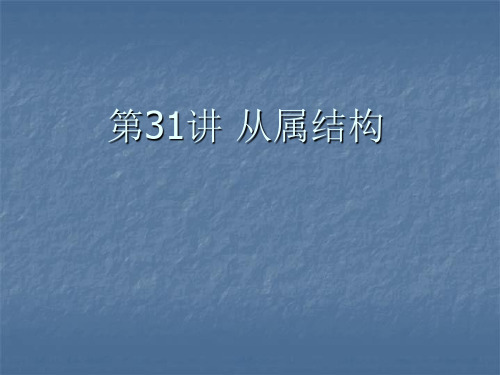

英语基础语法连词连词分为并列连词和从属连词两大类。
并列连词是连接主语与主语,谓语与谓语,句子与句子,分词与分词的词,它要求前后两部分有相同的形式和语法作用;而从属连词一般连接主句与从句,从句形式有名词性从句,定语从句和状语从句等。
1.并列连词并列连词可用来连接词与词,词组与词组,分句与分句。
常用的并列连词有:and(和),as well as(既……又),both... and(不但……而且),not only... but also(不但……而且),not ...but(不是……而是),neither...nor(既不……也不),either... or(不是……就是),or(或者),but (但是),yet(然而),for(因为),so(所以),while(而),when(这时)等。
如:Both my brother and my sister are teachers./ His room is bright but mine is gloomy(暗沉沉的)./ He can not only repair radios but also fix them./ It is a glorious(光荣的)yet difficult task./ Strike while iron is hot.2.从属连词从属连词是指在复合句中引导从句的连结词。
常见的从属连词有:(1)引导时间状语从句的:after, before, when, as, while, since, until, till, as soon as(2)引导原因状语从句的:because, since, as(3)引导让步状语从句的:although, though, no matter(无论), even if (though)(4)引导条件状语从句的:if, unless, once, so (as) long as(5)引导结果状语从句的:so... that..., such...that...(6)引导目的状语从句的:so that..., in order that...(7)引导比较状语从句的:as...as..., not so (as)... as...,... than...(8)引导方式状语从句的:as if...(9)引导主语,宾语或表语从句的连词主要有:that, whether, if三个。

并列连词与从属连词的区别与用法详解连词是连接词组、短语或句子的词语,其中,并列连词和从属连词是常用的两种类型。
本文将详细解释这两种连词的区别与用法。
一、并列连词(Coordinating Conjunctions)并列连词用于连接同等重要的词组、短语或句子。
常见的并列连词有"and"、"but"、"or"、"so"等。
以下是并列连词的主要用法:1. 连接两个主题相同或相似的词组或短语:- I like to read books and watch movies in my free time.我喜欢在空闲的时间里读书和看电影。
2. 连接两个具有相同功能的句子:- She is smart, but he is intelligent.她很聪明,但他很有才智。
3. 连接两个具有相反关系的句子:- I wanted to go to the party, but I was too tired.我想去参加派对,但我太累了。
4. 连接两个并列的独立句子:- I like coffee, and he prefers tea.我喜欢咖啡,而他更喜欢茶。
5. 连接两个句子并且表示因果关系:- He studied hard, so he passed the exam.他学习很努力,所以他通过了考试。
二、从属连词(Subordinating Conjunctions)从属连词用于连接一个主句和一个从句,从属连词引导的从句依赖于主句,无法独立存在。
常见的从属连词有"if"、"because"、"although"、"unless"等。
以下是从属连词的主要用法:1. 引导条件从句:- If it rains tomorrow, we will stay at home.如果明天下雨,我们会呆在家里。
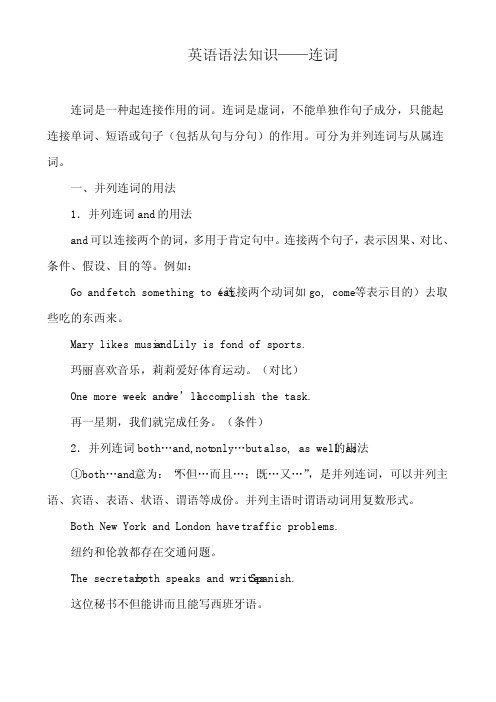
英语语法知识——连词连词是一种起连接作用的词。
连词是虚词,不能单独作句子成分,只能起连接单词、短语或句子(包括从句与分句)的作用。
可分为并列连词与从属连词。
一、并列连词的用法1.并列连词and的用法and可以连接两个的词,多用于肯定句中。
连接两个句子,表示因果、对比、条件、假设、目的等。
例如:(连接两个动词如go, come等表示目的)去取Go andfetch something to eat.些吃的东西来。
andLily is fond of sports.Mary likes music玛丽喜欢音乐,莉莉爱好体育运动。
(对比)One more week and we’ll accomplish the task.再一星期,我们就完成任务。
(条件)的用法2.并列连词both…and,not only…but also, as well as①both…and意为:“不但…而且…;既…又…”,是并列连词,可以并列主语、宾语、表语、状语、谓语等成份。
并列主语时谓语动词用复数形式。
Both New York and London have traffic problems.纽约和伦敦都存在交通问题。
Spanish.The secretaryboth speaks and writes这位秘书不但能讲而且能写西班牙语。
②not o nly…but also 意为:“不但...而且”,是并列连词,可以连接两个词,也可连接两个句子。
其中,but also 中的also可以省略。
not o nly…but also 可以连接句中所有的成份,连接并列主语时,其谓语动词根据就近原则,与所靠近的成分保持数的一致。
not o nly…but also 可以连接两个句子,not only 位于句首时, not only 后的句子要倒装。
Not only the students but (also) their teacher is enjoying the movie.不仅学生们津津有味地看着这部电影,而且他们的老师也是如此。
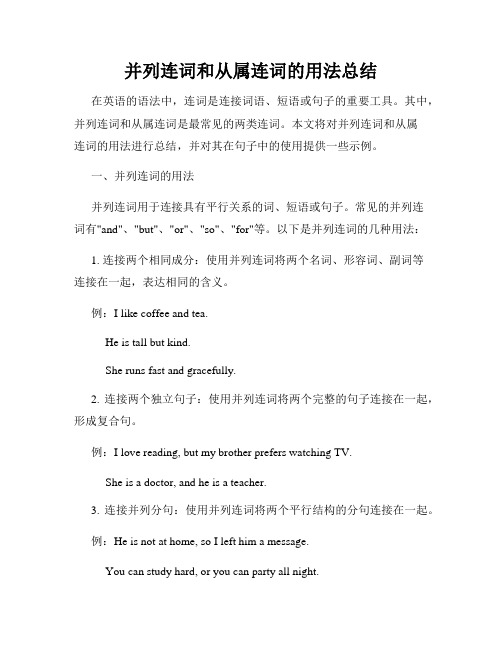
并列连词和从属连词的用法总结在英语的语法中,连词是连接词语、短语或句子的重要工具。
其中,并列连词和从属连词是最常见的两类连词。
本文将对并列连词和从属连词的用法进行总结,并对其在句子中的使用提供一些示例。
一、并列连词的用法并列连词用于连接具有平行关系的词、短语或句子。
常见的并列连词有"and"、"but"、"or"、"so"、"for"等。
以下是并列连词的几种用法:1. 连接两个相同成分:使用并列连词将两个名词、形容词、副词等连接在一起,表达相同的含义。
例:I like coffee and tea.He is tall but kind.She runs fast and gracefully.2. 连接两个独立句子:使用并列连词将两个完整的句子连接在一起,形成复合句。
例:I love reading, but my brother prefers watching TV.She is a doctor, and he is a teacher.3. 连接并列分句:使用并列连词将两个平行结构的分句连接在一起。
例:He is not at home, so I left him a message.You can study hard, or you can party all night.二、从属连词的用法从属连词用于引导从句,从句与主句之间形成因果、条件、目的、时间等关系。
常见的从属连词有"if"、"because"、"while"、"since"等。
以下是从属连词的几种用法:1. 引导条件从句:使用从属连词表达一个条件,明确主句的发生依赖于从句的情况。
例:If it rains tomorrow, we will stay at home.Unless you study hard, you will fail the exam.2. 引导原因从句:使用从属连词表达主句发生的原因。


并列连词和从属连词连词是一种虚词,它不能独立担任句子成分而只起连接词与词,短语与短语以及句与句的作用。
连词主要可分为两类:并列连词和从属连词。
并列连词用来连接平行的词、词组和分句.如:and,but, or, nor, so, therefore, yet, however, for, hence,as well as,both…and,not only…but also, either…or,neither…nor,(and)then等等。
1。
并列连词并列连词用来连接属于同一层次并具有相同句法功能的词;短语或句子。
并列连词包括:基本并列连词如and, or , but ,关联连词如either。
.。
or , neither。
nor ,not only.。
.but also ,both 。
.。
and,whether.。
.or 等;介于并列连词与从属连词之间的连词;介于并列连词与从属连词或介词之间的结构如as well as , as much as, rather than , more than, no less than 等;此外还有些’半连接词’,一些语法学家把它们称为连接副词,如nevertheless, however, meanwhile, otherwise,likewise 等,它们在句中做连接性状语。
这类连词主要是从逻辑上,而不是从形式上连接句子,其关系比较松散。
1)表示意义转折和对比的并列连词常见的有:but , while,whereas,still,yet ,nevertheless,likewise, anyway , only ,conversely , on the contrary,by this time, all the same , fortunately,on the other hand , in the meantime 等词语。
2)表示选择的并列连词常见的有:or,whether。

英语语法什么是连词连词在英语语法中扮演着非常重要的角色。
它们用于连接词、短语、句子和句子之间的关系,帮助我们组织思维和表达意思。
在本篇文章中,我将详细介绍连词的不同类型、用法和一些重要的注意事项。
一、连词的定义和分类连词是一类词性,用于连接词、短语、句子和句子之间的关系。
根据其功能和用法,连词可分为以下几类:1. 并列连词(Coordinating Conjunctions):用于连接同等重要的词、短语、句子或句子之间的关系。
常见的并列连词有"and"、"but"、"or"、"nor"、"for"、"yet"等。
2. 从属连词(Subordinating Conjunctions):用于引导从属从句,并将从属从句与主句连接起来。
从属连词在句子中起到连接主从句的作用。
常见的从属连词有"although"、"because"、"if"、"when"、"while"等。
3. 连接副词(Correlative Conjunctions):由两个或多个词组成,用于连接相同类型的词、短语或句子。
常见的连接副词有"either...or"、"neither...nor"、"both...and"、"not only...but also"等。
4. 连接代词(Relative Pronouns):既是代词,又是连词,引导定语从句,并将定语从句与主句连接起来。
常见的连接代词有"who"、"whom"、"whose"、"which"、"that"等。
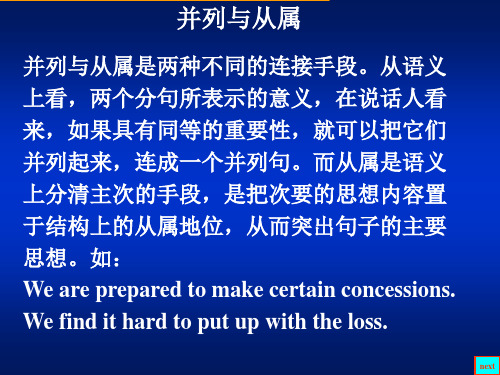
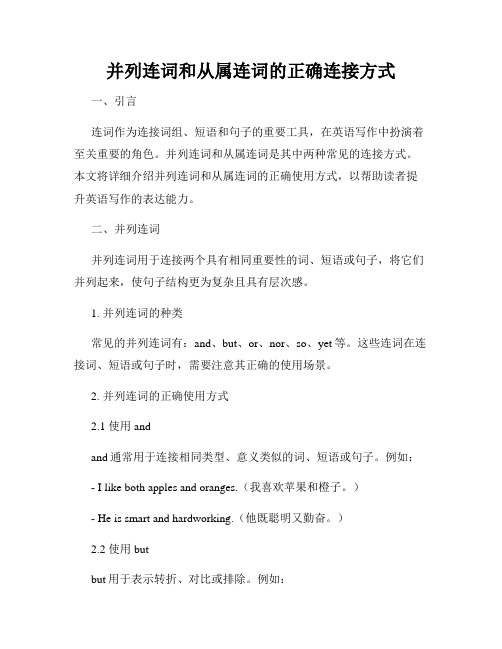
并列连词和从属连词的正确连接方式一、引言连词作为连接词组、短语和句子的重要工具,在英语写作中扮演着至关重要的角色。
并列连词和从属连词是其中两种常见的连接方式。
本文将详细介绍并列连词和从属连词的正确使用方式,以帮助读者提升英语写作的表达能力。
二、并列连词并列连词用于连接两个具有相同重要性的词、短语或句子,将它们并列起来,使句子结构更为复杂且具有层次感。
1. 并列连词的种类常见的并列连词有:and、but、or、nor、so、yet等。
这些连词在连接词、短语或句子时,需要注意其正确的使用场景。
2. 并列连词的正确使用方式2.1 使用andand通常用于连接相同类型、意义类似的词、短语或句子。
例如:- I like both apples and oranges.(我喜欢苹果和橙子。
)- He is smart and hardworking.(他既聪明又勤奋。
)2.2 使用butbut用于表示转折、对比或排除。
例如:- She is intelligent but sometimes lazy.(她聪明,但有时候懒惰。
)- I want to go to the party, but I have to finish my homework first.(我想去派对,但我必须先完成我的作业。
)2.3 使用or、noror用于表示选择关系,而nor表示否定选择。
例如:- You can choose coffee or tea.(你可以选择咖啡或茶。
)- He doesn't like vegetables, nor does he like fruits.(他不喜欢蔬菜,也不喜欢水果。
)2.4 使用soso通常用于表示因果关系、结果或推理。
例如:- He studied hard, so he passed the exam.(他学习很努力,所以他通过了考试。
)- It was raining, so we stayed at home.(下雨了,所以我们待在家里。

1、连词的含义:连接词与词、短语与短语、或引导从句的词叫连接词。
2、连词的分类:连词分为并列连接词和从属连接词两种。
1、并列连接词连接并列的词、短语、从句或句子。
常见的并列连接词有:and(和),but(但是),or(或者,否则),nor(也不), so(所以), however(然而,无论如何),for(因为),still(可是),as well as(也),both..and...(...和...), not only ...but also...(不但…而且…), either… or…(或…或…),neither… nor…(既不…也不…)等。
2、从属连接词用于引导从句,常见的从属连接词有:when(当…时候), while(正当…时候), after(在…之后), before(在…之前), since(自从), until(直到), although/though(虽然), if(假如), as(如…一样;由于), as …as…(和…一样), as far as(就…而言), as long as(只要), as soon as(一…就…), even if(即使), because(因为), unless (除非), than(比…), whether (是否…), in order that…(为了), so…that…(如此…以致), so that…(以便), now that…(现在既然), by the time…(到…时候), every time…(每当), as if…(仿佛),no matter when(或whenever)(无论何时),no matter where(或wherever)(无论在哪里)等。
[辨析](1)because、as、since、for的用法:because(因为)表示原因的语气最强,常表示必然的因果关系,从句一般放在主句后面;另外,回答why的问句只能用because. as(因为)表示一般的因果关系,语气比because弱,说明比较明显的原因,它引导的从句可以放在句首也可以放在句尾。

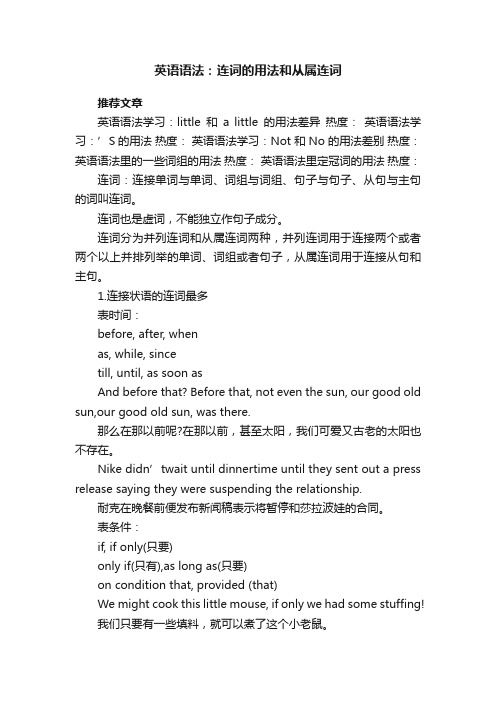
英语语法:连词的用法和从属连词推荐文章英语语法学习:little和a little的用法差异热度:英语语法学习:’S的用法热度:英语语法学习:Not 和 No 的用法差别热度:英语语法里的一些词组的用法热度:英语语法里定冠词的用法热度:连词:连接单词与单词、词组与词组、句子与句子、从句与主句的词叫连词。
连词也是虚词,不能独立作句子成分。
连词分为并列连词和从属连词两种,并列连词用于连接两个或者两个以上并排列举的单词、词组或者句子,从属连词用于连接从句和主句。
1.连接状语的连词最多表时间:before, after, whenas, while, sincetill, until, as soon asAnd before that? Before that, not even the sun, our good old sun,our good old sun, was there.那么在那以前呢?在那以前,甚至太阳,我们可爱又古老的太阳也不存在。
Nike didn’twait until dinnertime until they sent out a press release saying they were suspending the relationship.耐克在晚餐前便发布新闻稿表示将暂停和莎拉波娃的合同。
表条件:if, if only(只要)only if(只有),as long as(只要)on condition that, provided (that)We might cook this little mouse, if only we had some stuffing!我们只要有一些填料,就可以煮了这个小老鼠。
You may keep the book a further week provided that no one else requires it.倘若这本书没有其他人想借的话,你可以续借一个星期。

并列和从属第十-章 Coord ination and Subord ination11.0 In troductionCoordination: 由并列连接词(coordinator )把同一等级的单位连接起来;Subordination: 由从属连接词(subordinator )把不同等级的单位连接起来,从属从句提供背景信息支持主句•E.g.: Peter and Susan. (Coordination)We ' II have picnic if it ' s fine tomorrow. (Subordination)考点1 11.1.1 Coordi natorsWhile d rather live in a flat.While / Whereas they want a house, weWhile , whereas 接从句;but, yet 接词组While , whereas 可在句首使用,but, yelt 只可以在句中做连词whereas You like sports, whereas/ while/but/yet d rather read.11.1.2 Pun ctuati on betwee n coord inators并列连词间的标点如果只有2个unit 需要连接的话,一般中间加个连接词就好,… A and B如果有3个或者以上的单位需要连接,一般在最后一个单位前加连接词, 其他的都用逗号隔开。
A, B and CHe didn ' t play football, basketball or volleyball.Exception但是也可以有以下情况,A,B,C. / A and B and CFor linking 2 or more adjectives: 1.当adj.在副词位置的时候,往往在最后一个 adj.前加andHe was tall, dark and handsome. 2.当adj.在修饰位置的时候,表示中心词的特征时,往往用逗号隔开。

《英语语法》并列与从属分项测试练习-状语分句《英语语法》并列与从属分项测试练习1. We heard a loud sound of drums beating _______ the parade marched.A) till C) the momentB) while D) where2. ______, in 1788, the thirteen original states worked together under an agreement called the Articles of Confederation.A) Not until the Constitution was adopted C) Adopted by the ConstitutionB) The Constitution was adopted D) Until the Constitution was adopted3. The picture is not hanging ________ it should on the wall.A) until C) whereB) wherever D) when4. She didn’t hear what you said _______ she was completely absorbed in her work.A) that C) becauseB) now that D) lest5. ________ he will not accept the offer, I have to find someone else.A) Until C) As soon asB) Though D) Seeing that6. This is an ideal site for a university ________ it is far form the downtown area.A) provided that C) so thatB) now that D) in that7. It is _________ weather that I would like to go to the beach.A) so nice C) such a niceB) such nice D) so nice a8. Let’s finish our work ________ we can be free this evening.A) now that C) becauseB) than D) so that9. Batteries must be kept in dry places ________ electricity should leak away.A) where C) thatB) lest D) unless10. _______ a teenager, Fred could resist being told what to do and what not to do.A) Although C) In spite ofB) Despite D) Being11. Just as the builder is skilled in the handling of his bricks, _______ the experienced writer is skilled in the handling of his words.A) as C) soB) thus D) like12. The very essence of civil liberty consists in the right of every individual to claim the protection of laws,________ he receives an injury.A) whenever C) whateverB) wherever D) whereas13. _______, electrons are still smaller.A) As small atoms are C) As atoms are smallB) Small as atoms are D) Are small atoms14. _________ you fell in love with your boss, what would you do?A) Provide C) UnlessB) Supposing D) Except15. _______ she started to look for premises, she looked at the business property columns in the local paper.A) Not sooner than C) The momentB) While D) Hardly16. _________, the fire men were unable to quench the fire.A) Try they would C) What they triedB) As they tried D) Try as they would17. Angiosperms inhabit relatively diverse environments and may be found ______ higher plants can survive.A) there C) somewhereB) where D) then18. Y ou can arrive in Beijing earlier for the meeting _________ you don’t mind traveling b y air.A) provided C) thoughB) unless D) until19. No sooner had we started the experiment ________ we stopped it because of the cut-off of water.A) than C) thenB) when D) as20. Some companies have introduced flexible working time with less emphasis on pressure ________.A) than more on efficiency C) and more on efficiencyB) and more efficiency D) than efficiency21. Just as the value of a telephone network increases with each new phone added to the system, _______ the value of a computer system increase with each program that turns out.A) so C) and it doesB) so does D) so does it22. ________ classified as a carnivore, the North American grizzly bear eats berries and even grass.A) Just as C) AlthoughB) Because of D) Either23. _______ usually thought to end in northern New Mexico, the Rocky Mountains really extend southward to the frontier of Mexico.A) Despite C) WhileB) To be D) However24. The lenses in an optical microscope bend the light passing through a specimen to form an image of that specimen that is much larger _______ actually viewed.A) than it C) one thanB) than the one D) than one which25. Hydrogen is the fundamental element of the universe ________ it provides the building blocks from which the other elements are produced.A) so that C) but thatB) in that D) provided that26. _______, he does get irritated with her sometimes.A) As he likes her much C) Much as he likes herB) Much although he likes her D) Though much he likes her27. The engineers are going through with their project, ________ the expenses have risen.A) even though C) now thatB) just because D) as though28. Nearly all trees contain a mix of polymers that can burn like petroleum _________ properly extracted.A) after C) when itB) if D) before29. _______ recurring fear is out of proportion to any real danger, it is called a phobia.A) When C) WhichB) Whereas D) Whether30. _______ no conclusive evidence exists, many experts believe that the wheel was invented only once and then diffused to the rest of the world.A) Even C) AlthoughB) But D) So31. I don’t know what decision was taken at the conference ______ they haven’t reported to me yet.A) as C) providedB) because D) for32. He had no idea how difficult the experiment would be ______ he was halfway through it.A) since C) unless33. __________ we can make laws to protect certain animals, we are frequently incapable of controlling the environment.A) However C) WhateverB) While D) Provided34. Due to the development of the computers, it is ___________ man has suddenly become a millionaire of the mind.A) that C) likeB) as D) as if35. The early years of the United States government were characterized by a debate concerning ______ or individual states should have more power.A) whether the federal government C) that the federal governmentB) either the federal government D) the federal government36. Give me your telephone number ________ I need your help.A) whether C) so thatB) unless D) in case37. _________ to speak when the audience interrupted him.A) Hardly had he begun C) Not until he beganB) No sooner had he begun D) Scarcely did he begin38. _____ my father would not worry about my absence, I left a farewell note on the table.A) In order that C) UnlessB) For D) Until39. Y ou can arrive in Beijing earlier for the meeting _________ you don’t mind taking the night train.A) provided C) thoughB) unless D) until40. So quickly are science and technology advancing ___________ is a possibility today may be a reality tomorrow.A) that C) that whatB) what D) provided that41. The senior librarian at the circulation desk promised to get the book for me ________ she could remember who last borrowed it.A) ever since C) even thoughB) much as D) if only42. The chief reason for the population growth isn’t so much a rise in birth rates ________ a fall in death rates as a result of improvements in medical care.B) as D) or43. Doing your homework is a sure way to improve your test scores, and this is especially true _____ it comes to classroom tests.A) before C) sinceB) as D) when44. California has more light than it knows _________ to do with but everything else is expensive.A) how C) whichB) what D) where45. Talk to anyone in the drug industry, _________ you’ll soon discover that the science of genetics is the biggest thing to hit drug research since penicillin was discovered.A) or C) ForB) and D) so46. They criticized him_________he should make the same mistake again.A.unless C.lestB. so that D.in case of47.Y ou won't be able to find the job ________ you start right now.A. lest C. unlessB. so that D.that48.No sooner had they reached the station ________ the train left.A.until C. thenB. when D. than49. I had scarcely left the house ___ it began to rain.A. than C. whenB. then D. since50. It is a long time ___ I saw you last.A. when C. afterB. since D. as51. Put on more clothes, ____ you may catch cold.A. and C. thenB. or D. so52.Hardly had he finished the joke ___ the audience started laughing.A. and C. whenB. then D. as53. Y ou can borrow books from the library ___ you return them duly.A. even if C. unlessB. so that D. as long as54._____ we have finished the course, we shall start doing more revision work.A. From now C. Now thatB. Since that D. By now55. This traditional entertainment for children in America has never,____ I know, become popular in China.A. as far as C. so long asB. as much D. to the extent that56. The heart is ________ intelligent than the stomach, for they are both controlled by the brain.A) not so C) much moreB) not much D) no more57. Scientists generally agree that the Earth’s climate will warm up over the next 50 to 100 years ________ it has warmed in the 20,000 years since the Ice Age.A) as long as C) as soon asB) as much as D) as well as58. There ought to be less anxiety over the perceived risk of getting cancer than _________ in the public mind today.A) exists C) existingB) exist D) existed59. Do you enjoy listening to records? I find records are often ________, or better than an actual performance.A) as good as C) goodB) as good D) good as60. The number of registered participants in this year’s marathon was half __________.A) of last year’s C) of those of last yearB) those of last year’s D) that of last year’s61. The Social Security Retirement Program is made up of two trust funds, _________ could go penniless by next year.A) the larger one C) the largest oneB) the larger of which D) the largest of which62. Andrew, my father’s younger brother, will not be at the picnic, ________ to the family’s disappointment.A) much C) too muchB) more D) much more63. Smoking is so harmful to personal health that it kills ________ people each year than automobile accidents.A) seven more times C) over seven timesB) seven times more D) seven times64. The solution works only for couples who are self-employed, don’t have small children and get along________ to spend most of their time together.A) so well C) well asB) too well D) well enough65. It wasn’t so much that I disliked her _________ that I just wasn’t interested in the whole business.A) rather C) thanB) so D) as66.The neighbors do not consider him quite ___ as most of the evenings he awakes them with drunken singing.A. respected C. respectiveB. respectable D. respectful67.Although the main characters in the novel are so true to life, they are certainly_________.A. imaginary C. imaginativeB. imaginable D. imagining68.Western Nebraska generally receives less snow than _________ eastern Nebraska.A. does C. it does inB. in D. in it does69. By 1990, production in the area is expected to double ____ of 1980.A. that C. itB. one D. what70.His work was ___ , if not better than ours.A. as good as C. as better asB.so good as D.as well as71. "Do you regret paying two hundred dollars for this bicycle?""No, I would gladly have paid ___ for it."A. so much twice C. as twice muchB. twice so much D. twice as much72. Y ou can't be ___ careful in making the decision as it was such critical case.A. too C. soB. quite D. very73. Whatever the causes, English at the end of the 20th century is more widely spoken and written than any other language ____.A. would ever be C. ever wasB. has ever been D. had ever been74. Some countries have introduced flexible working time with less emphasis on pressure ____.A. and more on efficiency C. than more on efficiencyB. than efficiency D. and more efficiency75. We often sat in a small bar drinking considerably more than ___.A. he was in good health C. was good for his healthB. his good health was D. his health was good.76. ____ in the Atacama Desert.A. It never virtually rains C. Never it rains virtuallyB.It virtually never rains D. Never virtually it rains77. Society now requires the university to be a part of the community.___ students themselves expect to play a role in the affairs of society.A. Hence C. MoreoverB. However D. Otherwise78. We often advise him not to drink more wine ___ is good for his health.A than C. butB. as D. that79."Did the medicine make you feel better?" "No, ____ the worse I feel."A. the more I take medicine C. when I take more medicineB.more medicine I take D. the more medicine I take80. I enjoy listening to records, for I think they are often ___ an actual performance.A. as good as or better than C. good or better thanB. as good or better than D. as good as any other81. He seems to think that I am the ___ person in the office.A. least important C.lesser importantB. less important D. not most important82. Tom is clever than ___ in the class.A. any boy C. all the boysB. any other boy D. other boy83. Every student, no matter who he is, should be ____ to the teacher.A. respective C. respectfulB. respectable D. respecting84. Having got seriously injured in a military exercise______.A. the greater amount of energy consumed C. the greater the amount of energy consumedB. the greater amount of energy is consuming D. the greater consumes the amount of energy85. Certain programs work better for some ___ for others.A. and C. thanB. as D. but86. Beethoven is my favorite musician. I regard him as ___ other musicians.A. superior to C. more superior thanB. more superior to D. superior than87. My new glasses cost me __________ the last pair that I bought.A. three times as much as C. three times as many asB. three times more than D. as three times much as88. John’s record was ___________ on the team.A. not as good as any other player’s C. not so good as any player’sB. not so good as other players D. not so good like any other player’s89. Jack as a taxi-driver earns _________ he used to as a teacher.A. $ 5000 more than C. more $ 5000 thanB. as $ 5000 more than D. $ 5000 so much as90. The ability to store knowledge makes computers different from every other machine___ invented.A. ever C. asB. yet D. thus。